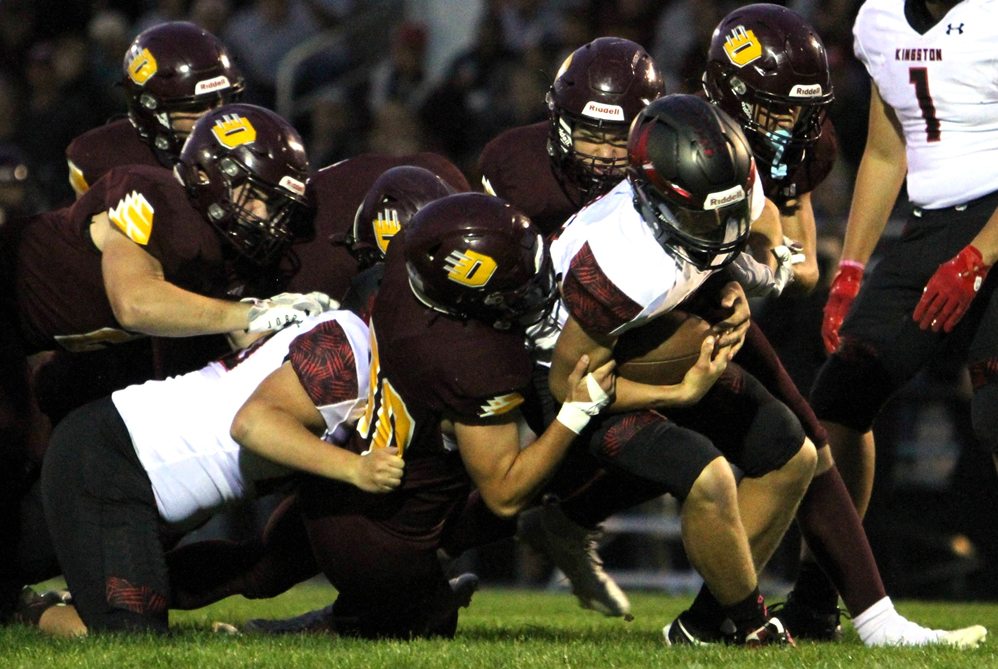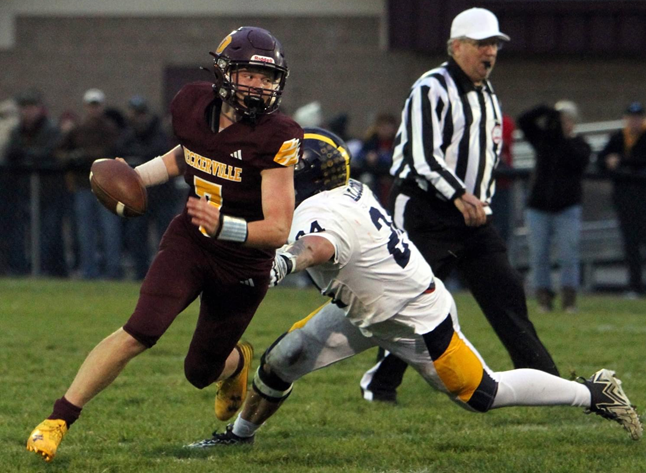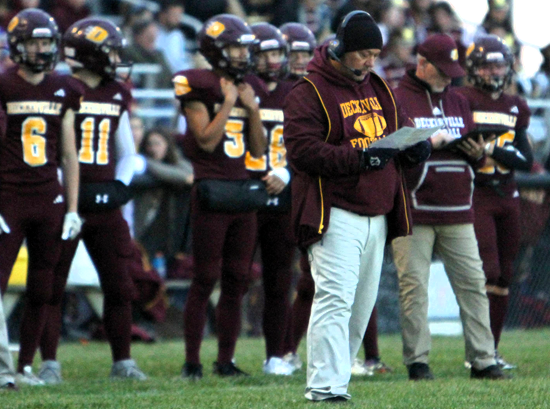
Inside Selection Sunday: Mapnalysis 2012
October 24, 2012
By Geoff Kimmerly
Second Half editor
Between double checking data for more than a third of our 626 football teams, and creating 136 first-round games for our most popular tournament, the morning of MHSAA football "Selection Sunday" is both one of the most exciting and nerve-wracking of the school year.
So for those scratching their heads the last few days over how we picked the brackets this season, I offer one question and one warning:
How would you have done so differently?
And before you answer, remember that moving the position of one school affects at least seven more – if not all 32 in that division.
This was the second year I was involved in the football selection process, which while appearing simple on its face actually is layered with hours of discussions, calculations, checking and re-checking, and anything else we at the MHSAA can do to make sure we’ve created the best tournament possible.
Simply put, it’s more than just drawing circles and calling them good.
Below are a brief description of what we do, the history behind the process, and some challenges we face each time we draw these brackets – including some examples of our toughest this time around.
The process
Our past: The MHSAA playoff structure – with 256 teams in eight divisions, and six wins equaling an automatic berth – debuted in 1999. An 8-player tournament was added in 2011, resulting in nine champions total when November is done.
That’s a long way from our start. The first playoffs were conducted in 1975 with four champions. Four more football classes were added in 1990 for a total of eight champions each fall. Through 1998, only 128 teams made the postseason, based on their playoff point averages within regions (four for each class) that were drawn before the beginning of the season. The drawing of Districts and Regions after the end of the regular season did not begin until the most recent playoff expansion.
In early years of the current process (or until the middle of the last decade), lines were drawn by hand. Dots representing qualifying schools were pasted on maps, one map for each division, and those maps were then covered by plastic sheets. Districts and Regionals literally were drawn with dry-erase markers.
Our present: After a late Saturday night tracking scores, we file in as the sun rises Sunday morning for a final round of gathering results we may still need (which can include making a few early a.m. calls to athletic directors). Then comes re-checking and triple-checking of enrollments, co-ops, some records and more before the numbers are crunched and the field of 256 is set.
Those teams are then split into eight equal divisions based on enrollment, and their locations are marked on digital maps that are projected on wall-size screens and then discussed by nearly half of the MHSAA staff plus a representative from the Michigan High School Football Coaches Association. Only the locations themselves are marked (by yellow dots) – not records, playoff points averages or names of the schools or towns. In fact, mentions of those are strictly prohibited. Records and playoff points are not part of the criteria. Matchups, rivalries, previous playoff pairings, etc. also DO NOT come into play.
Geography rules: Drawing Districts and Regionals is all about location. Travel distance and ease DO come into play. Yes, ease is important. Schools near the same major highway might be further from each other in mileage than other options but have a better trip. A good example this year is in Division 6, which has seven teams in the U.P. and the northern Lower Peninsula. That meant Shelby needed to be included with those teams to make eight, and left Montague to a District that includes Hemlock – more than halfway across the Lower Peninsula. But at least, in this case, much of that trip will be on one roadway, M-46.
There is certainly conversation about every possible option. The staff splits into two groups, each handling four divisions (plus one of the groups handles 8-player too), and then the entire committee comes together to view all nine maps. There wasn’t one division where the group as a whole said, “That looks great, what’s next?”
Observations and answers
A different ballgame: I was asked whatever happened to Districts, meaning teams opening with opponents nearby. Remember that with eight divisions and 32 teams in each, the difference between maximum and minimum enrollments for each division is smaller than it used to be with just four classes, and the probability of finding two schools in the same division next door to each other is lower. This is especially true for our smaller schools, and those pairings are more spread out. Division 7 provides an excellent example. Opponents Dansville and Ottawa Lake Whiteford are 84 miles apart. But in another option considered, Dansville would’ve played Gobles – and those two are separated by 114 miles.
Points still matter: And that means strength of schedule is a big factor. After Districts are drawn, playoff point average determines the home team for those two games and Regionals as well. There are five Districts in which the team with the best or second-best record did not get home games because those teams’ playoff point averages ranked third among the four teams in those brackets. A number of other Districts have 8-1 teams playing at other 8-1 teams. It’s true: there are times a school can’t help the opponents it plays, because of league affiliation perhaps, and they have no control over how an opponent does the rest of the season. But a Class B team playing in a league with Class D schools can’t expect to compare averages well against teams in their division who face similarly-sized opponents during the regular season.
No boating: This didn’t come up last season, but did twice Sunday. We had to decide if it was a better trip for teams in the thumb to go around Saginaw Bay to play northern opponents, or instead send teams a little bit south of the thumb but with a straight shots north. As the bird flies, the thumb teams were closer in some cases. But I’ve never heard of a team hopping into a boat to get to a playoff game.
The fifth wheels: The toughest lines to draw are around areas with five schools in the same division. Remember, Districts come in fours, and one dot affects the rest. The Grand Rapids area gave us tough calls because of five teams in Divisions 2 and 4. The same was true in the southwest corner in Division 7 and the southeast corner in Division 6. No matter how we circled it, one of those teams got stuck with a longer trip. This time, that group included Caledonia, Grand Rapids South Christian, Blissfield and Gobles.
It’s easy to say certain areas of these maps should’ve been drawn differently. But again, keep in mind a statewide view.
Some of our pairings could create gigantic matchups earlier in the playoffs than those teams might like. But again, who is to decide which teams are the best and which matchups most “gigantic” before they prove it on the field? At least three teams touted during this fall as potentially the best in the state this season didn’t even win their conference titles.
And as I said in this analysis last year, determining the playoff schedule is just one step in many. Nine MHSAA champions must survive until the end, regardless of which opponents they face along the way.
Their journeys begin Friday.

With Seasoned Seniors in Lead, Deckerville Set to Begin Another Title Pursuit
By
Paul Costanzo
Special for MHSAA.com
October 30, 2024
Preston Holman was an eighth grader when his family moved to Deckerville from the west side of the state, but it didn’t take long for him to realize how much football meant to the community.
 “Instantly, it was all clear to me that Deckerville was a powerhouse program around here, and if you’re going to play for them and Coach (Bill) Brown, you needed to be the best version of yourself,” said Holman, now a senior and all-state two-way lineman for the Eagles. “It was really cool. I remember my eighth-grade year, Deckerville lost to Mayville on Homecoming. I remember how upset the players were. I could tell in the atmosphere that Deckerville does not like to lose. But it was really cool to see how the community supported the program.”
“Instantly, it was all clear to me that Deckerville was a powerhouse program around here, and if you’re going to play for them and Coach (Bill) Brown, you needed to be the best version of yourself,” said Holman, now a senior and all-state two-way lineman for the Eagles. “It was really cool. I remember my eighth-grade year, Deckerville lost to Mayville on Homecoming. I remember how upset the players were. I could tell in the atmosphere that Deckerville does not like to lose. But it was really cool to see how the community supported the program.”
Holman and the Eagles have set themselves up to have that support through the 8-Player Division 1 Semifinals, should they keep winning, as the highest-rated team by playoff points in the bracket.
Deckerville, which finished a 9-0 regular season with a win over previous No. 1 Alcona in Week 9, will open the postseason at home Friday night against Bay City All Saints.
“It’s been great,” senior quarterback Hunter Garza said. “We’ve been taking it one game at a time and preparing all season for this, and I think the hard work is showing and paying off. This started three years ago, when we were all sophomores and freshmen, and the hard work is all paying off.”
When Garza and Holman were sophomores, they were part of a core group in that class who were playing key roles on the varsity. That group went 7-4 and won a playoff game in 2022, and Brown was starting to see the potential for something special in the future.
 A run to an 8-Player Division 2 Semifinal the next year proved him right.
A run to an 8-Player Division 2 Semifinal the next year proved him right.
“We have six kids that started when they were sophomores that are now seniors, and last year, our defense was one freshman, three sophomores and four juniors, so our whole defense is back,” Brown said. “So we knew we had a lot of potential there. We knew we had something going on, even back then. We knew when they were sophomores, even though they were pretty young. The next year, we got halfway through the season, and they were juniors that were starting to play like seniors.”
Knowing what he had coming back, and what a Deckerville crowd could bring during a playoff run, Brown set out to build a schedule that could guarantee the Eagles homefield advantage through the first three weeks of the postseason. That meant scheduling All Saints in Week 1 and Alcona in Week 9. Even had the Eagles lost those games, the benefit of playing a tougher schedule would have been a net positive. Of course, they won them, getting the best of both worlds.
“We play some tough competition in our conference,” Brown said. “But to get to 9-0, that’s pretty special.”
The Eagles outscored opponents, on average, 49-14 on their way to the program’s first unbeaten season since 2019, and fifth in Brown’s 32 years as head coach.
“I think we’ve played very good defense,” Brown said. “Last week (a 50-42 win against Alcona) was tough, but we were playing one of the best teams in the state. Sometimes you have to outscore someone. I think, defensively, we match up and are able to defend a lot of people. Then, being able to turn around and Hunter Garza is having a great year at quarterback – he can run, and he can throw – so I think we’re a little more diverse offensively.”
Garza has rushed for 1,134 yards and 21 touchdowns on 104 carries this season, leading an Eagles’ offense that is averaging 304.9 yards per game on the ground. Senior Parker Merriman had added 859 yards and 11 TDs.
 Garza also has thrown for 747 yards and nine touchdowns on just 76 pass attempts.
Garza also has thrown for 747 yards and nine touchdowns on just 76 pass attempts.
Defensively, the Eagles specialize in getting teams out of sync, as they have recorded 42 tackles for loss as a team, led by Holman’s 17. He also has nine sacks, while sophomore Brandon Halowitz leads the team with 83 tackles, including 13 for loss and five sacks.
Being a defensive stalwart is nothing new for the Eagles. When they joined the 8-player ranks in 2012, they brought a smashmouth style to what had been a wide-open division, and won a Finals title. The score of that championship game against Bellaire: 14-12.
They’ve made the postseason in each of the 12 years since, advancing to Finals in 2016 and 2017.
“Our goal each year is to win the state championship,” Brown said. “Maybe those seem like lofty goals for many, but I think you have to do that. And, as it goes, right now we’re peaking at it. Last year, nobody would have thought we were going to make a run and get to the Semifinal. I would say the expectations are high for us, and I think that gives our team the drive to always be better than the team that did it before.”
Managing to chase those goals while remaining grounded in the day-to-day work necessary to reach them can be tough. But with senior leaders like Garza and Holman, Brown is confident his team will stay on the right path.
“Deckerville has such a good winning tradition, that it does put a lot of pressure on us, but Coach always says, ‘Just because you’re Deckerville, you’re not guaranteed to make the playoffs,’” Garza said. “Just because you wear the D, doesn’t mean you’re going to make a run in the playoffs. You gotta go out and work for it. You have to go out and win it.”
 Paul Costanzo served as a sportswriter at The Port Huron Times Herald from 2006-15, including three years as lead sportswriter, and prior to that as sports editor at the Hillsdale Daily News from 2005-06. He can be reached at [email protected] with story ideas for Genesee, Lapeer, St. Clair, Sanilac, Huron, Tuscola, Saginaw, Bay, Arenac, Midland and Gladwin counties.
Paul Costanzo served as a sportswriter at The Port Huron Times Herald from 2006-15, including three years as lead sportswriter, and prior to that as sports editor at the Hillsdale Daily News from 2005-06. He can be reached at [email protected] with story ideas for Genesee, Lapeer, St. Clair, Sanilac, Huron, Tuscola, Saginaw, Bay, Arenac, Midland and Gladwin counties.
PHOTOS (Top) The Deckerville defense converges on a Kingston ball carrier during this season’s 44-0 victory. (Middle) Hunter Garza eludes an Alcona defender last week. (Below) Eagles coach Bill Brown, in headset, checks his chart on the sideline. (Photos by Mike Gallagher/Saranac County News.)

